Impact of Rebranding on Khalsa Aid's Operations: A Business Report
VerifiedAdded on 2022/07/21
|28
|5426
|35
Report
AI Summary
This report examines the impact of rebranding on the operations of Khalsa Aid, an international NGO. It begins with an introduction to Khalsa Aid and the rationale for studying the effects of rebranding on its operational efficiency. The report then outlines the project's aim, objectives, and research questions, followed by a review of secondary research, including resource dependency theory, domain approaches, stakeholder theory, homophily, and institutional theory, and highlights the literature gap. The report also includes primary research, an evaluation, and concludes with recommendations to address the communication challenges and rebranding issues faced by Khalsa Aid. The study emphasizes the importance of clear communication and effective management in non-governmental organizations, particularly in the context of rebranding efforts.
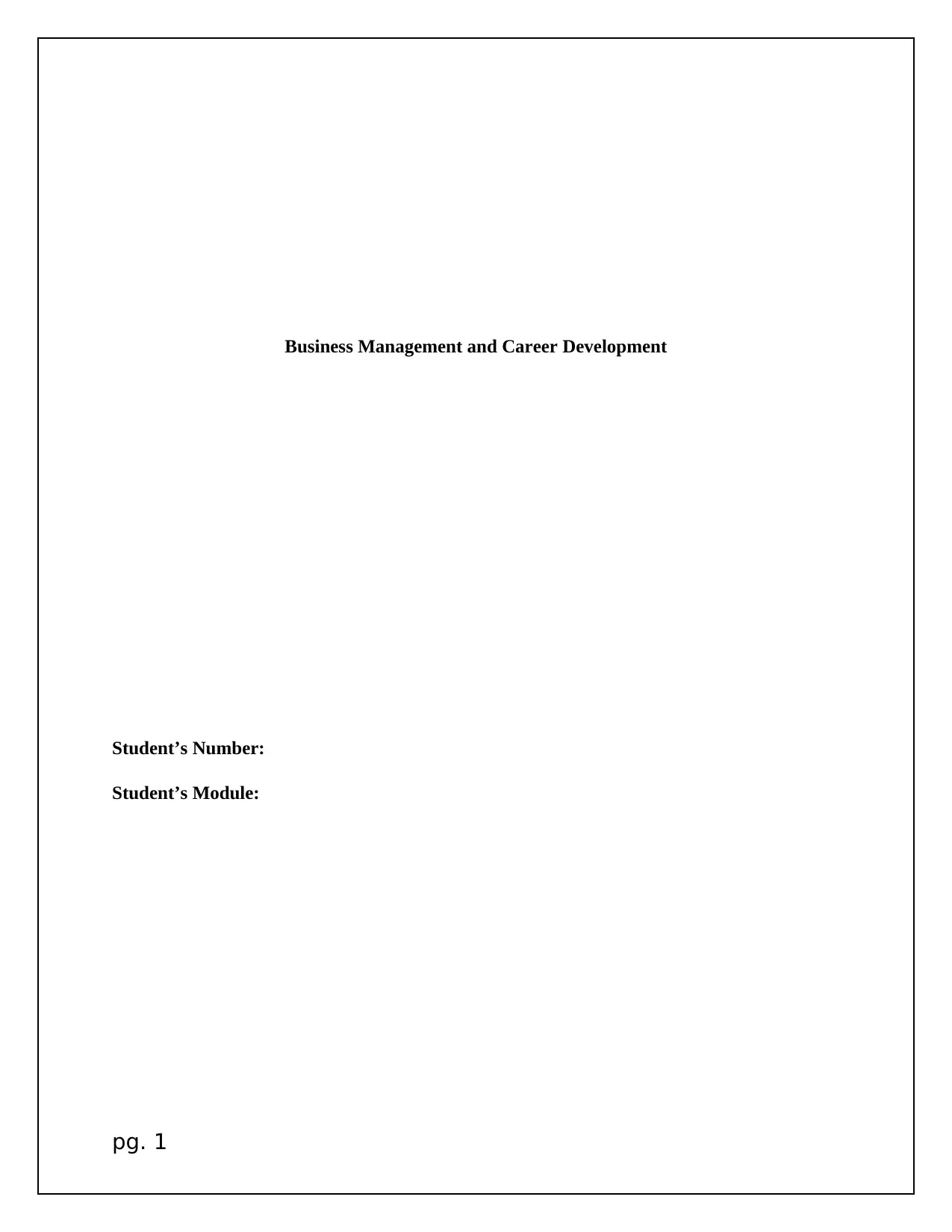
Business Management and Career Development
Student’s Number:
Student’s Module:
pg. 1
Student’s Number:
Student’s Module:
pg. 1
Paraphrase This Document
Need a fresh take? Get an instant paraphrase of this document with our AI Paraphraser
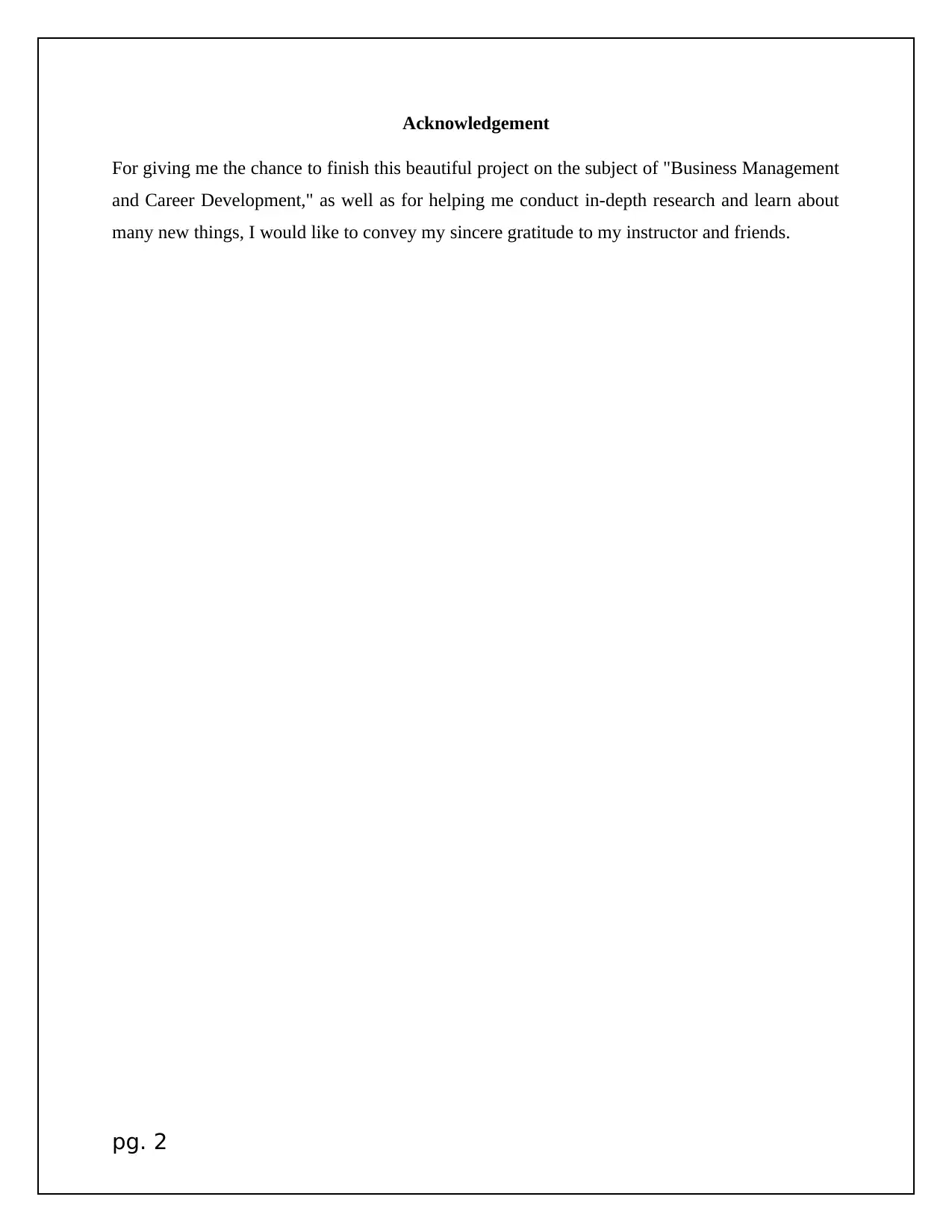
Acknowledgement
For giving me the chance to finish this beautiful project on the subject of "Business Management
and Career Development," as well as for helping me conduct in-depth research and learn about
many new things, I would like to convey my sincere gratitude to my instructor and friends.
pg. 2
For giving me the chance to finish this beautiful project on the subject of "Business Management
and Career Development," as well as for helping me conduct in-depth research and learn about
many new things, I would like to convey my sincere gratitude to my instructor and friends.
pg. 2
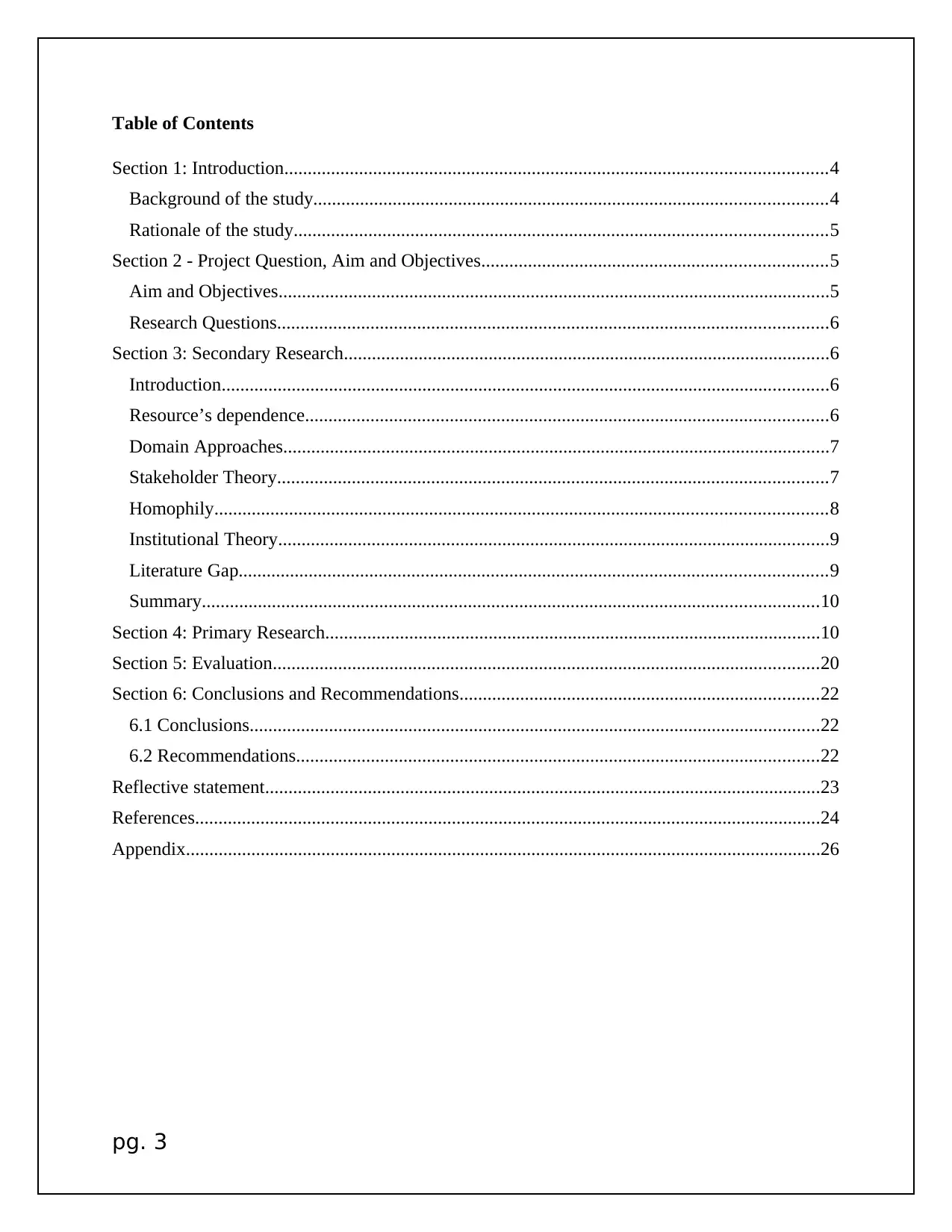
Table of Contents
Section 1: Introduction....................................................................................................................4
Background of the study..............................................................................................................4
Rationale of the study..................................................................................................................5
Section 2 - Project Question, Aim and Objectives..........................................................................5
Aim and Objectives......................................................................................................................5
Research Questions......................................................................................................................6
Section 3: Secondary Research........................................................................................................6
Introduction..................................................................................................................................6
Resource’s dependence................................................................................................................6
Domain Approaches.....................................................................................................................7
Stakeholder Theory......................................................................................................................7
Homophily...................................................................................................................................8
Institutional Theory......................................................................................................................9
Literature Gap..............................................................................................................................9
Summary....................................................................................................................................10
Section 4: Primary Research..........................................................................................................10
Section 5: Evaluation.....................................................................................................................20
Section 6: Conclusions and Recommendations.............................................................................22
6.1 Conclusions..........................................................................................................................22
6.2 Recommendations................................................................................................................22
Reflective statement.......................................................................................................................23
References......................................................................................................................................24
Appendix........................................................................................................................................26
pg. 3
Section 1: Introduction....................................................................................................................4
Background of the study..............................................................................................................4
Rationale of the study..................................................................................................................5
Section 2 - Project Question, Aim and Objectives..........................................................................5
Aim and Objectives......................................................................................................................5
Research Questions......................................................................................................................6
Section 3: Secondary Research........................................................................................................6
Introduction..................................................................................................................................6
Resource’s dependence................................................................................................................6
Domain Approaches.....................................................................................................................7
Stakeholder Theory......................................................................................................................7
Homophily...................................................................................................................................8
Institutional Theory......................................................................................................................9
Literature Gap..............................................................................................................................9
Summary....................................................................................................................................10
Section 4: Primary Research..........................................................................................................10
Section 5: Evaluation.....................................................................................................................20
Section 6: Conclusions and Recommendations.............................................................................22
6.1 Conclusions..........................................................................................................................22
6.2 Recommendations................................................................................................................22
Reflective statement.......................................................................................................................23
References......................................................................................................................................24
Appendix........................................................................................................................................26
pg. 3
⊘ This is a preview!⊘
Do you want full access?
Subscribe today to unlock all pages.

Trusted by 1+ million students worldwide
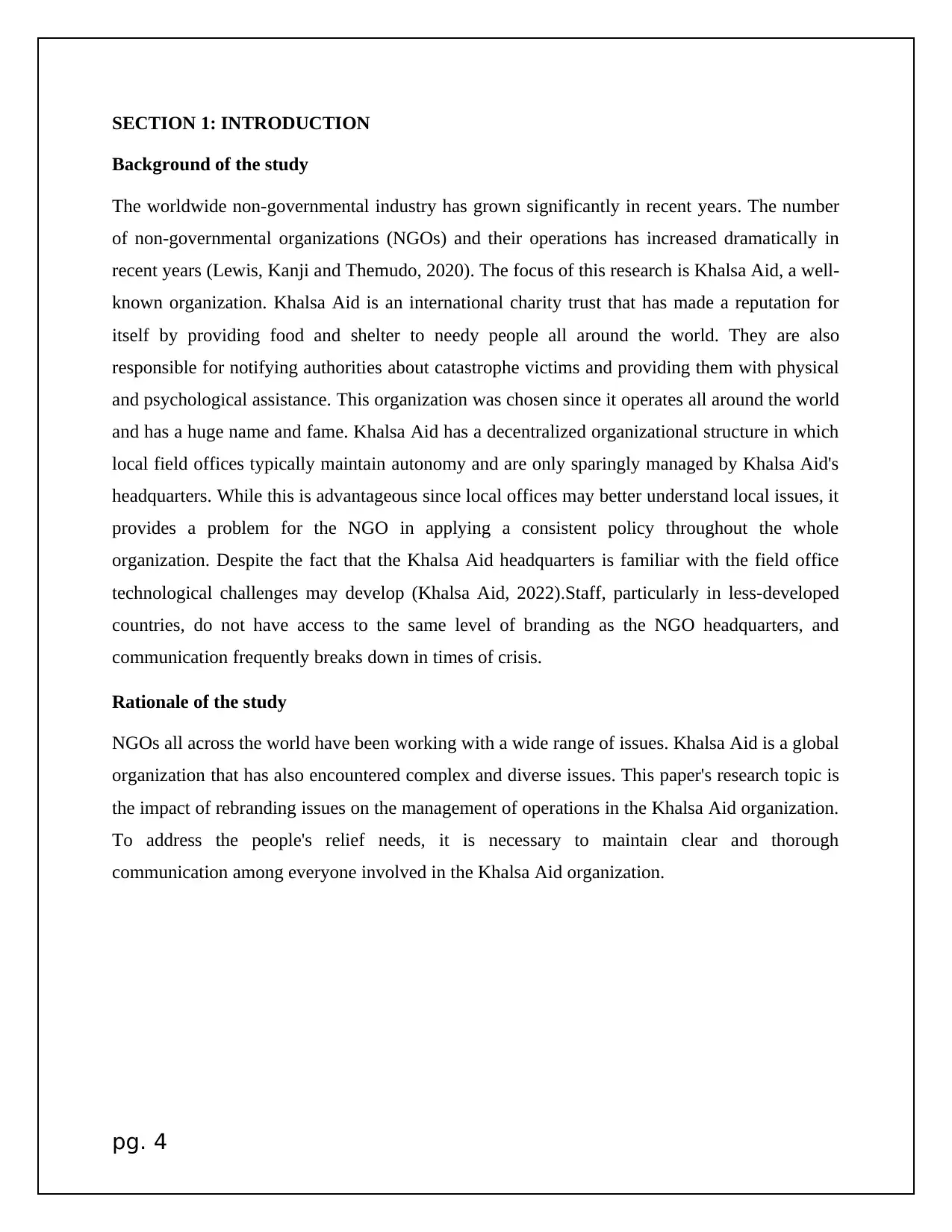
SECTION 1: INTRODUCTION
Background of the study
The worldwide non-governmental industry has grown significantly in recent years. The number
of non-governmental organizations (NGOs) and their operations has increased dramatically in
recent years (Lewis, Kanji and Themudo, 2020). The focus of this research is Khalsa Aid, a well-
known organization. Khalsa Aid is an international charity trust that has made a reputation for
itself by providing food and shelter to needy people all around the world. They are also
responsible for notifying authorities about catastrophe victims and providing them with physical
and psychological assistance. This organization was chosen since it operates all around the world
and has a huge name and fame. Khalsa Aid has a decentralized organizational structure in which
local field offices typically maintain autonomy and are only sparingly managed by Khalsa Aid's
headquarters. While this is advantageous since local offices may better understand local issues, it
provides a problem for the NGO in applying a consistent policy throughout the whole
organization. Despite the fact that the Khalsa Aid headquarters is familiar with the field office
technological challenges may develop (Khalsa Aid, 2022).Staff, particularly in less-developed
countries, do not have access to the same level of branding as the NGO headquarters, and
communication frequently breaks down in times of crisis.
Rationale of the study
NGOs all across the world have been working with a wide range of issues. Khalsa Aid is a global
organization that has also encountered complex and diverse issues. This paper's research topic is
the impact of rebranding issues on the management of operations in the Khalsa Aid organization.
To address the people's relief needs, it is necessary to maintain clear and thorough
communication among everyone involved in the Khalsa Aid organization.
pg. 4
Background of the study
The worldwide non-governmental industry has grown significantly in recent years. The number
of non-governmental organizations (NGOs) and their operations has increased dramatically in
recent years (Lewis, Kanji and Themudo, 2020). The focus of this research is Khalsa Aid, a well-
known organization. Khalsa Aid is an international charity trust that has made a reputation for
itself by providing food and shelter to needy people all around the world. They are also
responsible for notifying authorities about catastrophe victims and providing them with physical
and psychological assistance. This organization was chosen since it operates all around the world
and has a huge name and fame. Khalsa Aid has a decentralized organizational structure in which
local field offices typically maintain autonomy and are only sparingly managed by Khalsa Aid's
headquarters. While this is advantageous since local offices may better understand local issues, it
provides a problem for the NGO in applying a consistent policy throughout the whole
organization. Despite the fact that the Khalsa Aid headquarters is familiar with the field office
technological challenges may develop (Khalsa Aid, 2022).Staff, particularly in less-developed
countries, do not have access to the same level of branding as the NGO headquarters, and
communication frequently breaks down in times of crisis.
Rationale of the study
NGOs all across the world have been working with a wide range of issues. Khalsa Aid is a global
organization that has also encountered complex and diverse issues. This paper's research topic is
the impact of rebranding issues on the management of operations in the Khalsa Aid organization.
To address the people's relief needs, it is necessary to maintain clear and thorough
communication among everyone involved in the Khalsa Aid organization.
pg. 4
Paraphrase This Document
Need a fresh take? Get an instant paraphrase of this document with our AI Paraphraser
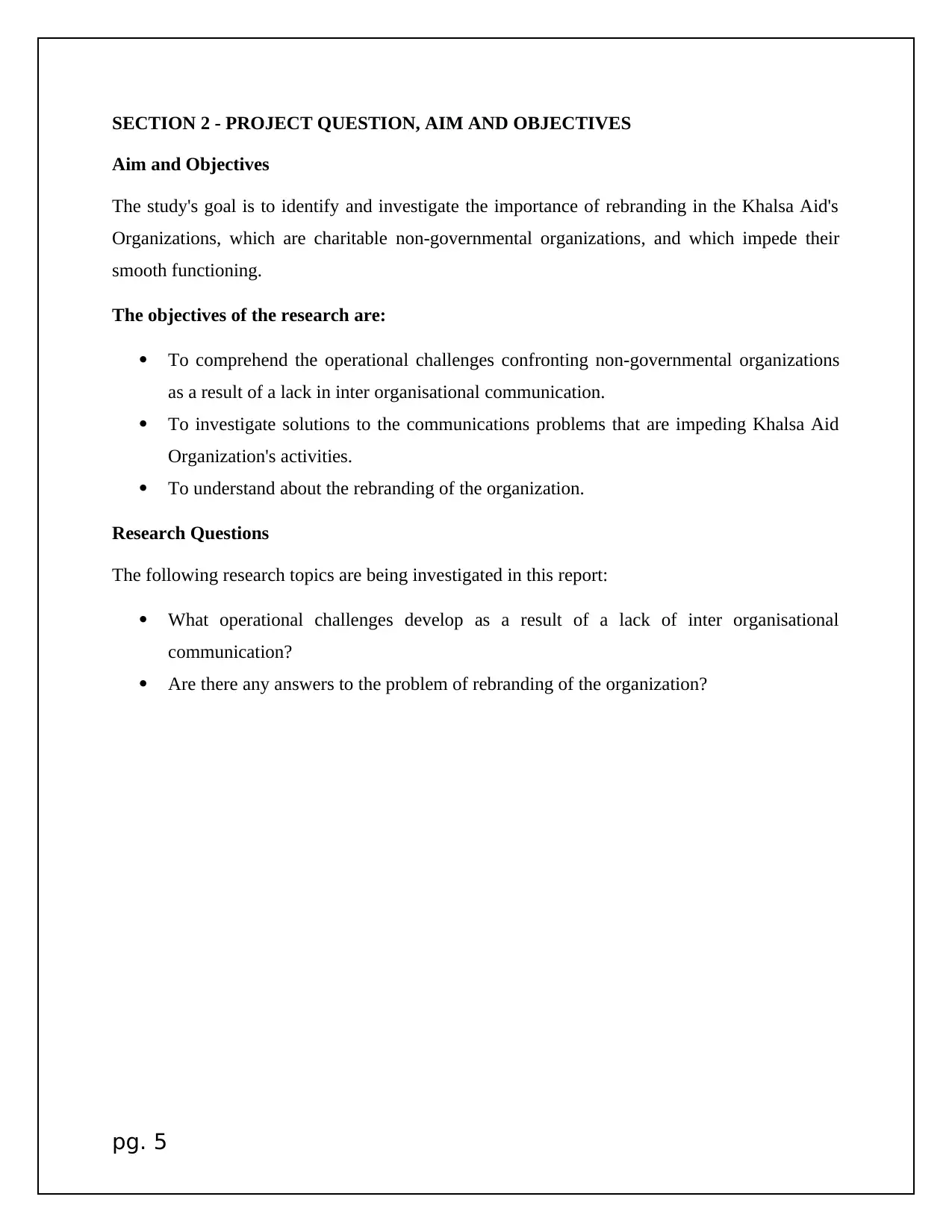
SECTION 2 - PROJECT QUESTION, AIM AND OBJECTIVES
Aim and Objectives
The study's goal is to identify and investigate the importance of rebranding in the Khalsa Aid's
Organizations, which are charitable non-governmental organizations, and which impede their
smooth functioning.
The objectives of the research are:
To comprehend the operational challenges confronting non-governmental organizations
as a result of a lack in inter organisational communication.
To investigate solutions to the communications problems that are impeding Khalsa Aid
Organization's activities.
To understand about the rebranding of the organization.
Research Questions
The following research topics are being investigated in this report:
What operational challenges develop as a result of a lack of inter organisational
communication?
Are there any answers to the problem of rebranding of the organization?
pg. 5
Aim and Objectives
The study's goal is to identify and investigate the importance of rebranding in the Khalsa Aid's
Organizations, which are charitable non-governmental organizations, and which impede their
smooth functioning.
The objectives of the research are:
To comprehend the operational challenges confronting non-governmental organizations
as a result of a lack in inter organisational communication.
To investigate solutions to the communications problems that are impeding Khalsa Aid
Organization's activities.
To understand about the rebranding of the organization.
Research Questions
The following research topics are being investigated in this report:
What operational challenges develop as a result of a lack of inter organisational
communication?
Are there any answers to the problem of rebranding of the organization?
pg. 5
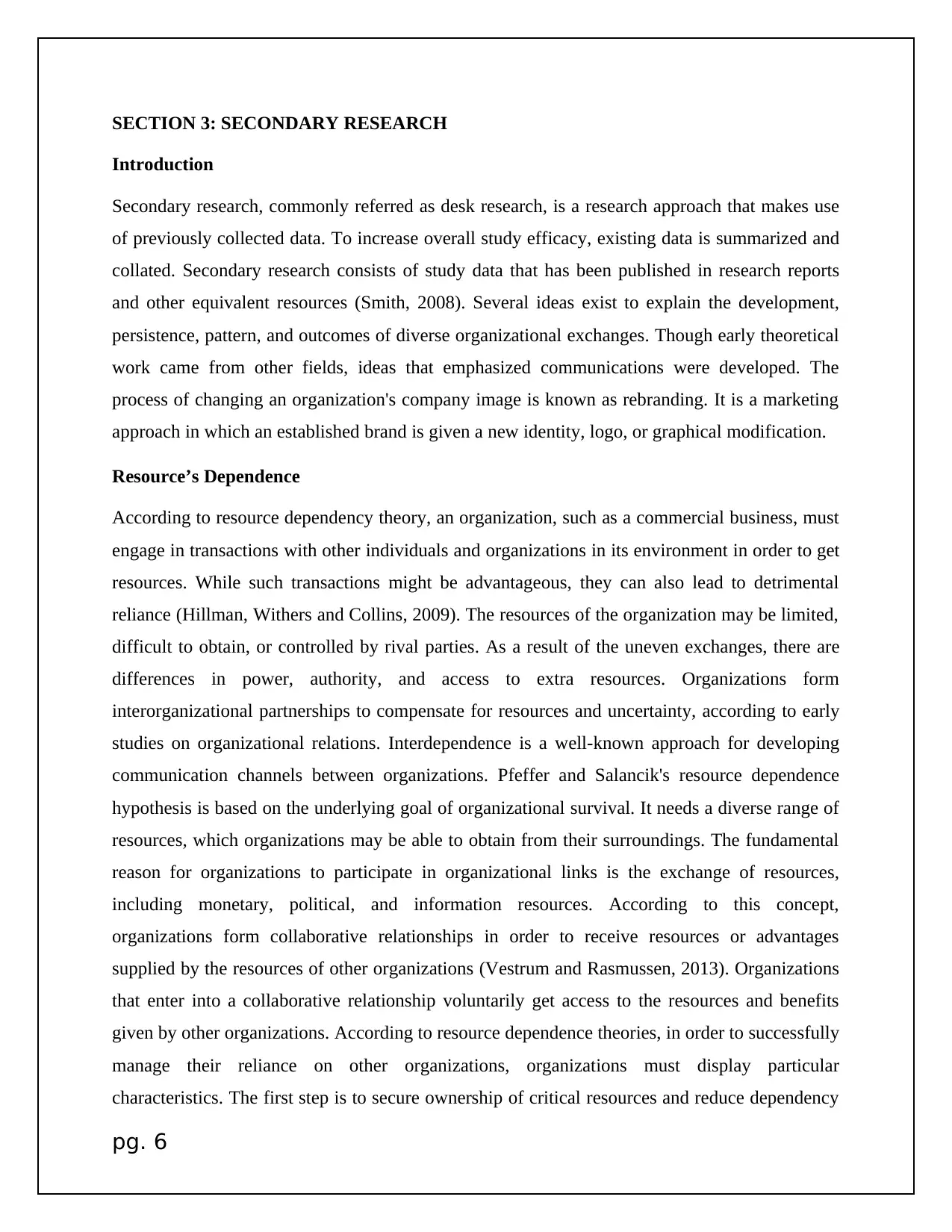
SECTION 3: SECONDARY RESEARCH
Introduction
Secondary research, commonly referred as desk research, is a research approach that makes use
of previously collected data. To increase overall study efficacy, existing data is summarized and
collated. Secondary research consists of study data that has been published in research reports
and other equivalent resources (Smith, 2008). Several ideas exist to explain the development,
persistence, pattern, and outcomes of diverse organizational exchanges. Though early theoretical
work came from other fields, ideas that emphasized communications were developed. The
process of changing an organization's company image is known as rebranding. It is a marketing
approach in which an established brand is given a new identity, logo, or graphical modification.
Resource’s Dependence
According to resource dependency theory, an organization, such as a commercial business, must
engage in transactions with other individuals and organizations in its environment in order to get
resources. While such transactions might be advantageous, they can also lead to detrimental
reliance (Hillman, Withers and Collins, 2009). The resources of the organization may be limited,
difficult to obtain, or controlled by rival parties. As a result of the uneven exchanges, there are
differences in power, authority, and access to extra resources. Organizations form
interorganizational partnerships to compensate for resources and uncertainty, according to early
studies on organizational relations. Interdependence is a well-known approach for developing
communication channels between organizations. Pfeffer and Salancik's resource dependence
hypothesis is based on the underlying goal of organizational survival. It needs a diverse range of
resources, which organizations may be able to obtain from their surroundings. The fundamental
reason for organizations to participate in organizational links is the exchange of resources,
including monetary, political, and information resources. According to this concept,
organizations form collaborative relationships in order to receive resources or advantages
supplied by the resources of other organizations (Vestrum and Rasmussen, 2013). Organizations
that enter into a collaborative relationship voluntarily get access to the resources and benefits
given by other organizations. According to resource dependence theories, in order to successfully
manage their reliance on other organizations, organizations must display particular
characteristics. The first step is to secure ownership of critical resources and reduce dependency
pg. 6
Introduction
Secondary research, commonly referred as desk research, is a research approach that makes use
of previously collected data. To increase overall study efficacy, existing data is summarized and
collated. Secondary research consists of study data that has been published in research reports
and other equivalent resources (Smith, 2008). Several ideas exist to explain the development,
persistence, pattern, and outcomes of diverse organizational exchanges. Though early theoretical
work came from other fields, ideas that emphasized communications were developed. The
process of changing an organization's company image is known as rebranding. It is a marketing
approach in which an established brand is given a new identity, logo, or graphical modification.
Resource’s Dependence
According to resource dependency theory, an organization, such as a commercial business, must
engage in transactions with other individuals and organizations in its environment in order to get
resources. While such transactions might be advantageous, they can also lead to detrimental
reliance (Hillman, Withers and Collins, 2009). The resources of the organization may be limited,
difficult to obtain, or controlled by rival parties. As a result of the uneven exchanges, there are
differences in power, authority, and access to extra resources. Organizations form
interorganizational partnerships to compensate for resources and uncertainty, according to early
studies on organizational relations. Interdependence is a well-known approach for developing
communication channels between organizations. Pfeffer and Salancik's resource dependence
hypothesis is based on the underlying goal of organizational survival. It needs a diverse range of
resources, which organizations may be able to obtain from their surroundings. The fundamental
reason for organizations to participate in organizational links is the exchange of resources,
including monetary, political, and information resources. According to this concept,
organizations form collaborative relationships in order to receive resources or advantages
supplied by the resources of other organizations (Vestrum and Rasmussen, 2013). Organizations
that enter into a collaborative relationship voluntarily get access to the resources and benefits
given by other organizations. According to resource dependence theories, in order to successfully
manage their reliance on other organizations, organizations must display particular
characteristics. The first step is to secure ownership of critical resources and reduce dependency
pg. 6
⊘ This is a preview!⊘
Do you want full access?
Subscribe today to unlock all pages.

Trusted by 1+ million students worldwide
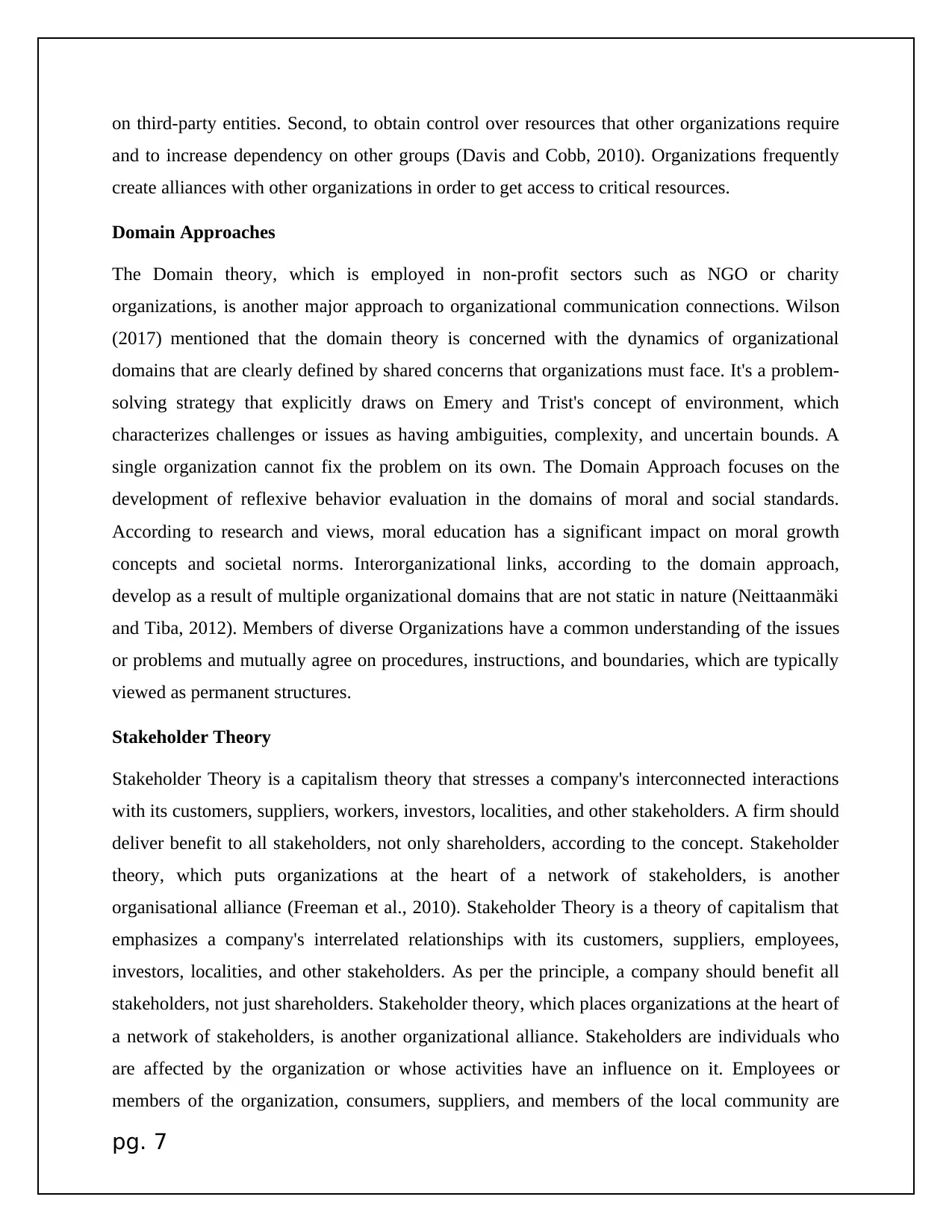
on third-party entities. Second, to obtain control over resources that other organizations require
and to increase dependency on other groups (Davis and Cobb, 2010). Organizations frequently
create alliances with other organizations in order to get access to critical resources.
Domain Approaches
The Domain theory, which is employed in non-profit sectors such as NGO or charity
organizations, is another major approach to organizational communication connections. Wilson
(2017) mentioned that the domain theory is concerned with the dynamics of organizational
domains that are clearly defined by shared concerns that organizations must face. It's a problem-
solving strategy that explicitly draws on Emery and Trist's concept of environment, which
characterizes challenges or issues as having ambiguities, complexity, and uncertain bounds. A
single organization cannot fix the problem on its own. The Domain Approach focuses on the
development of reflexive behavior evaluation in the domains of moral and social standards.
According to research and views, moral education has a significant impact on moral growth
concepts and societal norms. Interorganizational links, according to the domain approach,
develop as a result of multiple organizational domains that are not static in nature (Neittaanmäki
and Tiba, 2012). Members of diverse Organizations have a common understanding of the issues
or problems and mutually agree on procedures, instructions, and boundaries, which are typically
viewed as permanent structures.
Stakeholder Theory
Stakeholder Theory is a capitalism theory that stresses a company's interconnected interactions
with its customers, suppliers, workers, investors, localities, and other stakeholders. A firm should
deliver benefit to all stakeholders, not only shareholders, according to the concept. Stakeholder
theory, which puts organizations at the heart of a network of stakeholders, is another
organisational alliance (Freeman et al., 2010). Stakeholder Theory is a theory of capitalism that
emphasizes a company's interrelated relationships with its customers, suppliers, employees,
investors, localities, and other stakeholders. As per the principle, a company should benefit all
stakeholders, not just shareholders. Stakeholder theory, which places organizations at the heart of
a network of stakeholders, is another organizational alliance. Stakeholders are individuals who
are affected by the organization or whose activities have an influence on it. Employees or
members of the organization, consumers, suppliers, and members of the local community are
pg. 7
and to increase dependency on other groups (Davis and Cobb, 2010). Organizations frequently
create alliances with other organizations in order to get access to critical resources.
Domain Approaches
The Domain theory, which is employed in non-profit sectors such as NGO or charity
organizations, is another major approach to organizational communication connections. Wilson
(2017) mentioned that the domain theory is concerned with the dynamics of organizational
domains that are clearly defined by shared concerns that organizations must face. It's a problem-
solving strategy that explicitly draws on Emery and Trist's concept of environment, which
characterizes challenges or issues as having ambiguities, complexity, and uncertain bounds. A
single organization cannot fix the problem on its own. The Domain Approach focuses on the
development of reflexive behavior evaluation in the domains of moral and social standards.
According to research and views, moral education has a significant impact on moral growth
concepts and societal norms. Interorganizational links, according to the domain approach,
develop as a result of multiple organizational domains that are not static in nature (Neittaanmäki
and Tiba, 2012). Members of diverse Organizations have a common understanding of the issues
or problems and mutually agree on procedures, instructions, and boundaries, which are typically
viewed as permanent structures.
Stakeholder Theory
Stakeholder Theory is a capitalism theory that stresses a company's interconnected interactions
with its customers, suppliers, workers, investors, localities, and other stakeholders. A firm should
deliver benefit to all stakeholders, not only shareholders, according to the concept. Stakeholder
theory, which puts organizations at the heart of a network of stakeholders, is another
organisational alliance (Freeman et al., 2010). Stakeholder Theory is a theory of capitalism that
emphasizes a company's interrelated relationships with its customers, suppliers, employees,
investors, localities, and other stakeholders. As per the principle, a company should benefit all
stakeholders, not just shareholders. Stakeholder theory, which places organizations at the heart of
a network of stakeholders, is another organizational alliance. Stakeholders are individuals who
are affected by the organization or whose activities have an influence on it. Employees or
members of the organization, consumers, suppliers, and members of the local community are
pg. 7
Paraphrase This Document
Need a fresh take? Get an instant paraphrase of this document with our AI Paraphraser
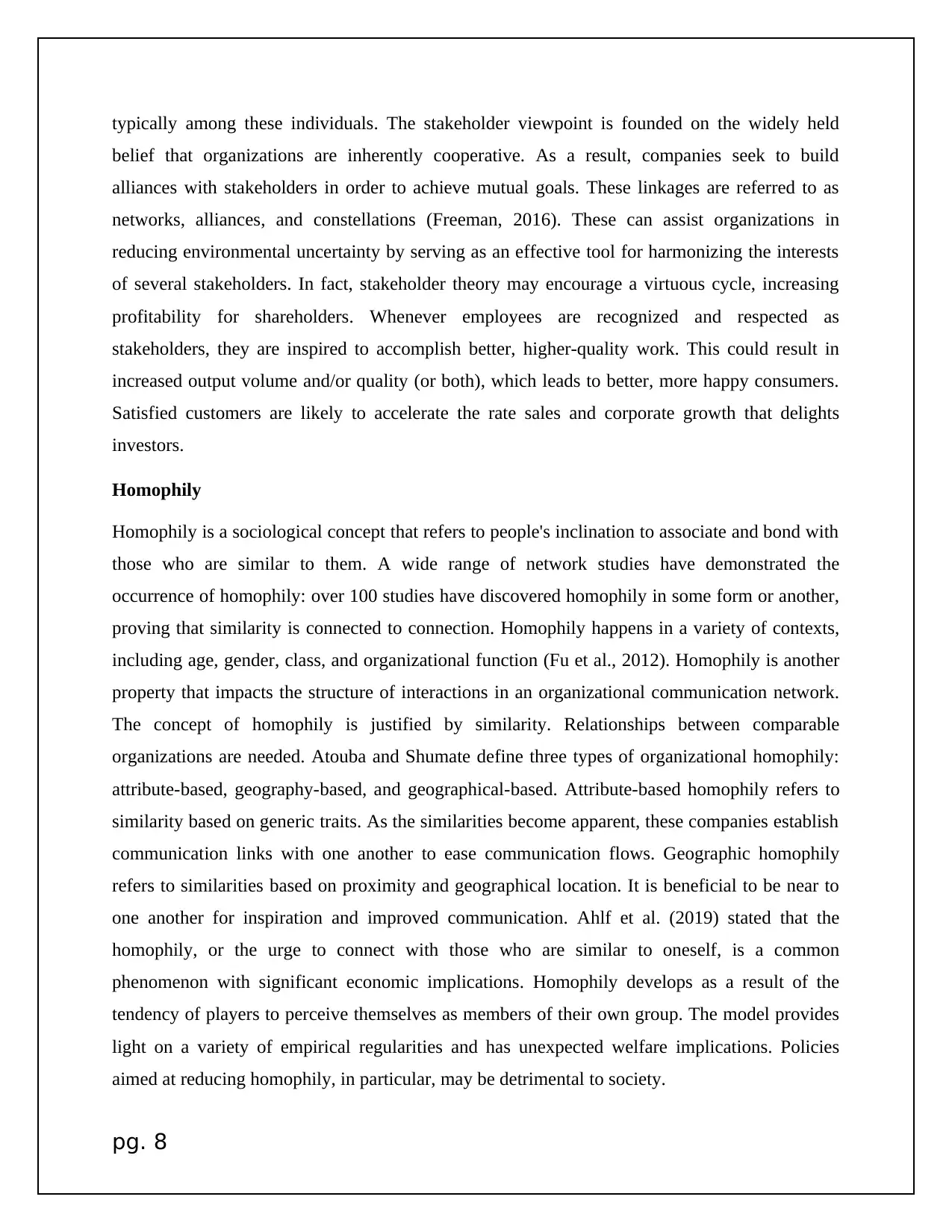
typically among these individuals. The stakeholder viewpoint is founded on the widely held
belief that organizations are inherently cooperative. As a result, companies seek to build
alliances with stakeholders in order to achieve mutual goals. These linkages are referred to as
networks, alliances, and constellations (Freeman, 2016). These can assist organizations in
reducing environmental uncertainty by serving as an effective tool for harmonizing the interests
of several stakeholders. In fact, stakeholder theory may encourage a virtuous cycle, increasing
profitability for shareholders. Whenever employees are recognized and respected as
stakeholders, they are inspired to accomplish better, higher-quality work. This could result in
increased output volume and/or quality (or both), which leads to better, more happy consumers.
Satisfied customers are likely to accelerate the rate sales and corporate growth that delights
investors.
Homophily
Homophily is a sociological concept that refers to people's inclination to associate and bond with
those who are similar to them. A wide range of network studies have demonstrated the
occurrence of homophily: over 100 studies have discovered homophily in some form or another,
proving that similarity is connected to connection. Homophily happens in a variety of contexts,
including age, gender, class, and organizational function (Fu et al., 2012). Homophily is another
property that impacts the structure of interactions in an organizational communication network.
The concept of homophily is justified by similarity. Relationships between comparable
organizations are needed. Atouba and Shumate define three types of organizational homophily:
attribute-based, geography-based, and geographical-based. Attribute-based homophily refers to
similarity based on generic traits. As the similarities become apparent, these companies establish
communication links with one another to ease communication flows. Geographic homophily
refers to similarities based on proximity and geographical location. It is beneficial to be near to
one another for inspiration and improved communication. Ahlf et al. (2019) stated that the
homophily, or the urge to connect with those who are similar to oneself, is a common
phenomenon with significant economic implications. Homophily develops as a result of the
tendency of players to perceive themselves as members of their own group. The model provides
light on a variety of empirical regularities and has unexpected welfare implications. Policies
aimed at reducing homophily, in particular, may be detrimental to society.
pg. 8
belief that organizations are inherently cooperative. As a result, companies seek to build
alliances with stakeholders in order to achieve mutual goals. These linkages are referred to as
networks, alliances, and constellations (Freeman, 2016). These can assist organizations in
reducing environmental uncertainty by serving as an effective tool for harmonizing the interests
of several stakeholders. In fact, stakeholder theory may encourage a virtuous cycle, increasing
profitability for shareholders. Whenever employees are recognized and respected as
stakeholders, they are inspired to accomplish better, higher-quality work. This could result in
increased output volume and/or quality (or both), which leads to better, more happy consumers.
Satisfied customers are likely to accelerate the rate sales and corporate growth that delights
investors.
Homophily
Homophily is a sociological concept that refers to people's inclination to associate and bond with
those who are similar to them. A wide range of network studies have demonstrated the
occurrence of homophily: over 100 studies have discovered homophily in some form or another,
proving that similarity is connected to connection. Homophily happens in a variety of contexts,
including age, gender, class, and organizational function (Fu et al., 2012). Homophily is another
property that impacts the structure of interactions in an organizational communication network.
The concept of homophily is justified by similarity. Relationships between comparable
organizations are needed. Atouba and Shumate define three types of organizational homophily:
attribute-based, geography-based, and geographical-based. Attribute-based homophily refers to
similarity based on generic traits. As the similarities become apparent, these companies establish
communication links with one another to ease communication flows. Geographic homophily
refers to similarities based on proximity and geographical location. It is beneficial to be near to
one another for inspiration and improved communication. Ahlf et al. (2019) stated that the
homophily, or the urge to connect with those who are similar to oneself, is a common
phenomenon with significant economic implications. Homophily develops as a result of the
tendency of players to perceive themselves as members of their own group. The model provides
light on a variety of empirical regularities and has unexpected welfare implications. Policies
aimed at reducing homophily, in particular, may be detrimental to society.
pg. 8
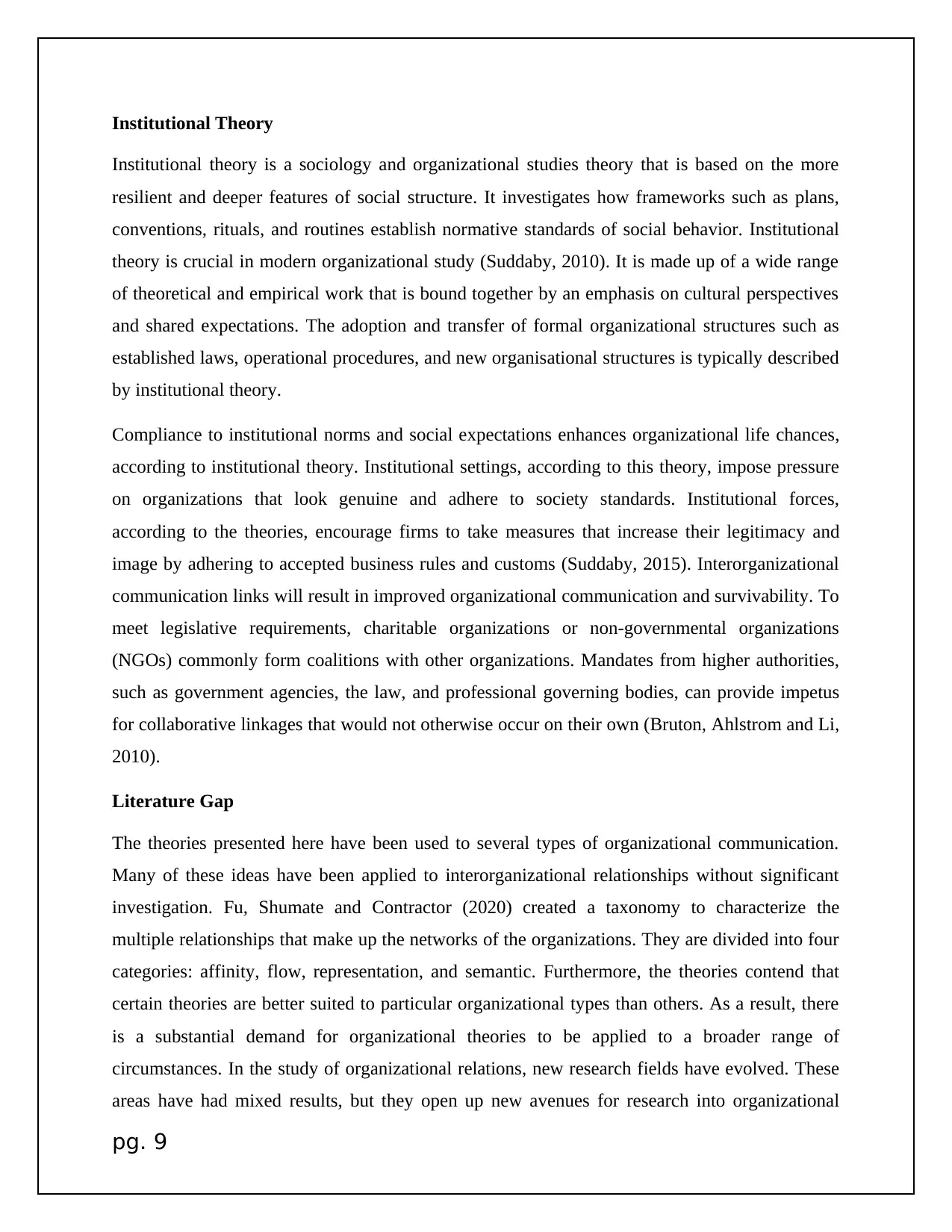
Institutional Theory
Institutional theory is a sociology and organizational studies theory that is based on the more
resilient and deeper features of social structure. It investigates how frameworks such as plans,
conventions, rituals, and routines establish normative standards of social behavior. Institutional
theory is crucial in modern organizational study (Suddaby, 2010). It is made up of a wide range
of theoretical and empirical work that is bound together by an emphasis on cultural perspectives
and shared expectations. The adoption and transfer of formal organizational structures such as
established laws, operational procedures, and new organisational structures is typically described
by institutional theory.
Compliance to institutional norms and social expectations enhances organizational life chances,
according to institutional theory. Institutional settings, according to this theory, impose pressure
on organizations that look genuine and adhere to society standards. Institutional forces,
according to the theories, encourage firms to take measures that increase their legitimacy and
image by adhering to accepted business rules and customs (Suddaby, 2015). Interorganizational
communication links will result in improved organizational communication and survivability. To
meet legislative requirements, charitable organizations or non-governmental organizations
(NGOs) commonly form coalitions with other organizations. Mandates from higher authorities,
such as government agencies, the law, and professional governing bodies, can provide impetus
for collaborative linkages that would not otherwise occur on their own (Bruton, Ahlstrom and Li,
2010).
Literature Gap
The theories presented here have been used to several types of organizational communication.
Many of these ideas have been applied to interorganizational relationships without significant
investigation. Fu, Shumate and Contractor (2020) created a taxonomy to characterize the
multiple relationships that make up the networks of the organizations. They are divided into four
categories: affinity, flow, representation, and semantic. Furthermore, the theories contend that
certain theories are better suited to particular organizational types than others. As a result, there
is a substantial demand for organizational theories to be applied to a broader range of
circumstances. In the study of organizational relations, new research fields have evolved. These
areas have had mixed results, but they open up new avenues for research into organizational
pg. 9
Institutional theory is a sociology and organizational studies theory that is based on the more
resilient and deeper features of social structure. It investigates how frameworks such as plans,
conventions, rituals, and routines establish normative standards of social behavior. Institutional
theory is crucial in modern organizational study (Suddaby, 2010). It is made up of a wide range
of theoretical and empirical work that is bound together by an emphasis on cultural perspectives
and shared expectations. The adoption and transfer of formal organizational structures such as
established laws, operational procedures, and new organisational structures is typically described
by institutional theory.
Compliance to institutional norms and social expectations enhances organizational life chances,
according to institutional theory. Institutional settings, according to this theory, impose pressure
on organizations that look genuine and adhere to society standards. Institutional forces,
according to the theories, encourage firms to take measures that increase their legitimacy and
image by adhering to accepted business rules and customs (Suddaby, 2015). Interorganizational
communication links will result in improved organizational communication and survivability. To
meet legislative requirements, charitable organizations or non-governmental organizations
(NGOs) commonly form coalitions with other organizations. Mandates from higher authorities,
such as government agencies, the law, and professional governing bodies, can provide impetus
for collaborative linkages that would not otherwise occur on their own (Bruton, Ahlstrom and Li,
2010).
Literature Gap
The theories presented here have been used to several types of organizational communication.
Many of these ideas have been applied to interorganizational relationships without significant
investigation. Fu, Shumate and Contractor (2020) created a taxonomy to characterize the
multiple relationships that make up the networks of the organizations. They are divided into four
categories: affinity, flow, representation, and semantic. Furthermore, the theories contend that
certain theories are better suited to particular organizational types than others. As a result, there
is a substantial demand for organizational theories to be applied to a broader range of
circumstances. In the study of organizational relations, new research fields have evolved. These
areas have had mixed results, but they open up new avenues for research into organizational
pg. 9
⊘ This is a preview!⊘
Do you want full access?
Subscribe today to unlock all pages.

Trusted by 1+ million students worldwide
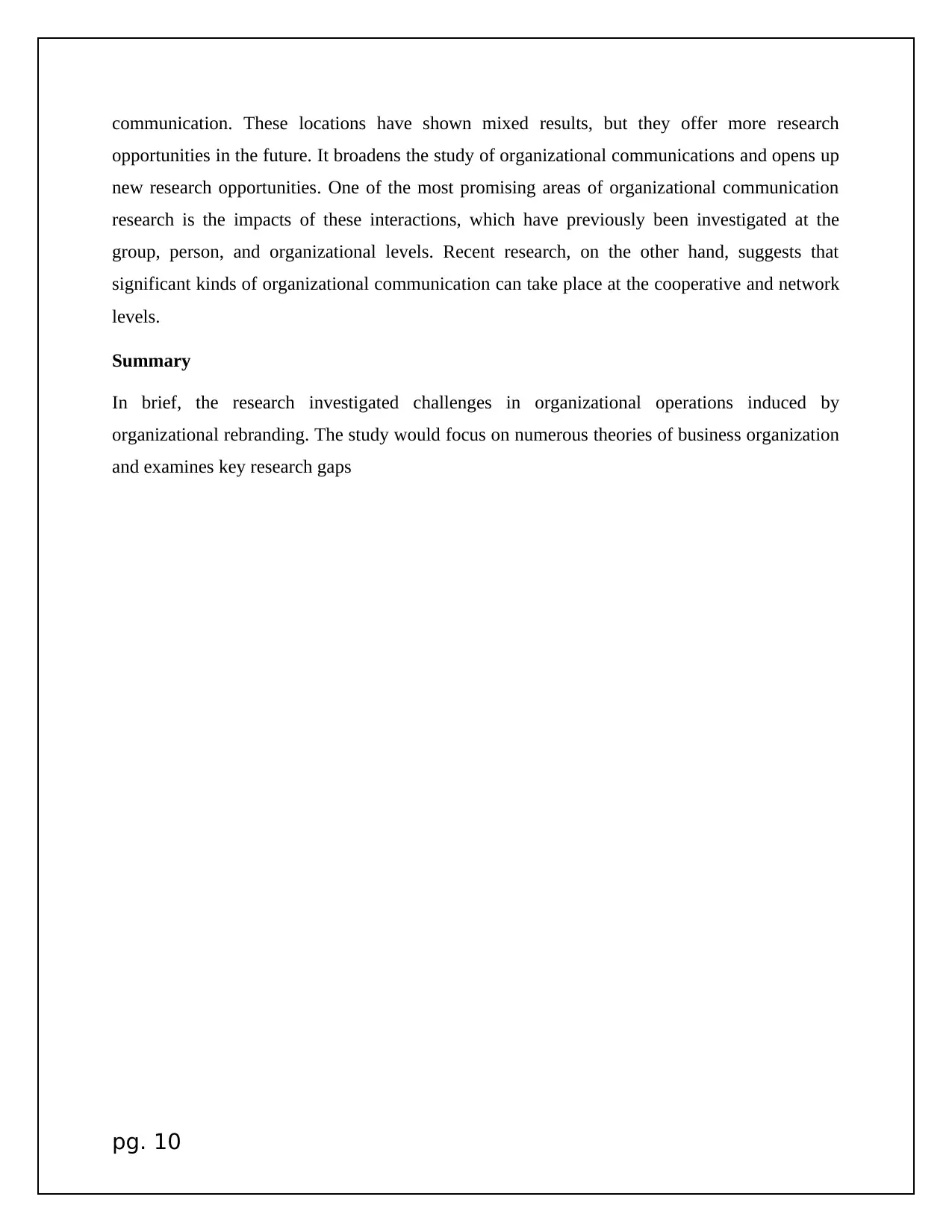
communication. These locations have shown mixed results, but they offer more research
opportunities in the future. It broadens the study of organizational communications and opens up
new research opportunities. One of the most promising areas of organizational communication
research is the impacts of these interactions, which have previously been investigated at the
group, person, and organizational levels. Recent research, on the other hand, suggests that
significant kinds of organizational communication can take place at the cooperative and network
levels.
Summary
In brief, the research investigated challenges in organizational operations induced by
organizational rebranding. The study would focus on numerous theories of business organization
and examines key research gaps
pg. 10
opportunities in the future. It broadens the study of organizational communications and opens up
new research opportunities. One of the most promising areas of organizational communication
research is the impacts of these interactions, which have previously been investigated at the
group, person, and organizational levels. Recent research, on the other hand, suggests that
significant kinds of organizational communication can take place at the cooperative and network
levels.
Summary
In brief, the research investigated challenges in organizational operations induced by
organizational rebranding. The study would focus on numerous theories of business organization
and examines key research gaps
pg. 10
Paraphrase This Document
Need a fresh take? Get an instant paraphrase of this document with our AI Paraphraser
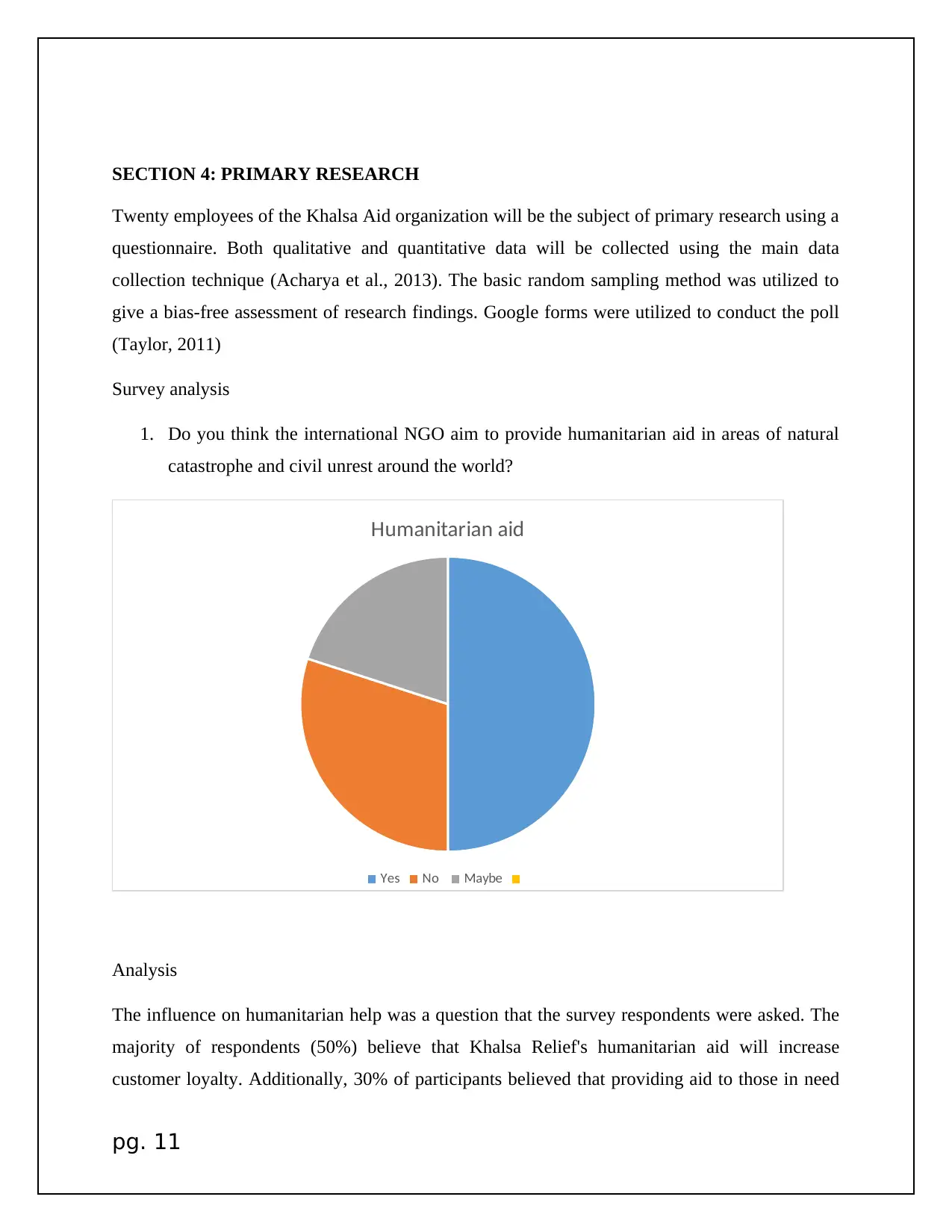
SECTION 4: PRIMARY RESEARCH
Twenty employees of the Khalsa Aid organization will be the subject of primary research using a
questionnaire. Both qualitative and quantitative data will be collected using the main data
collection technique (Acharya et al., 2013). The basic random sampling method was utilized to
give a bias-free assessment of research findings. Google forms were utilized to conduct the poll
(Taylor, 2011)
Survey analysis
1. Do you think the international NGO aim to provide humanitarian aid in areas of natural
catastrophe and civil unrest around the world?
Humanitarian aid
Yes No Maybe
Analysis
The influence on humanitarian help was a question that the survey respondents were asked. The
majority of respondents (50%) believe that Khalsa Relief's humanitarian aid will increase
customer loyalty. Additionally, 30% of participants believed that providing aid to those in need
pg. 11
Twenty employees of the Khalsa Aid organization will be the subject of primary research using a
questionnaire. Both qualitative and quantitative data will be collected using the main data
collection technique (Acharya et al., 2013). The basic random sampling method was utilized to
give a bias-free assessment of research findings. Google forms were utilized to conduct the poll
(Taylor, 2011)
Survey analysis
1. Do you think the international NGO aim to provide humanitarian aid in areas of natural
catastrophe and civil unrest around the world?
Humanitarian aid
Yes No Maybe
Analysis
The influence on humanitarian help was a question that the survey respondents were asked. The
majority of respondents (50%) believe that Khalsa Relief's humanitarian aid will increase
customer loyalty. Additionally, 30% of participants believed that providing aid to those in need
pg. 11
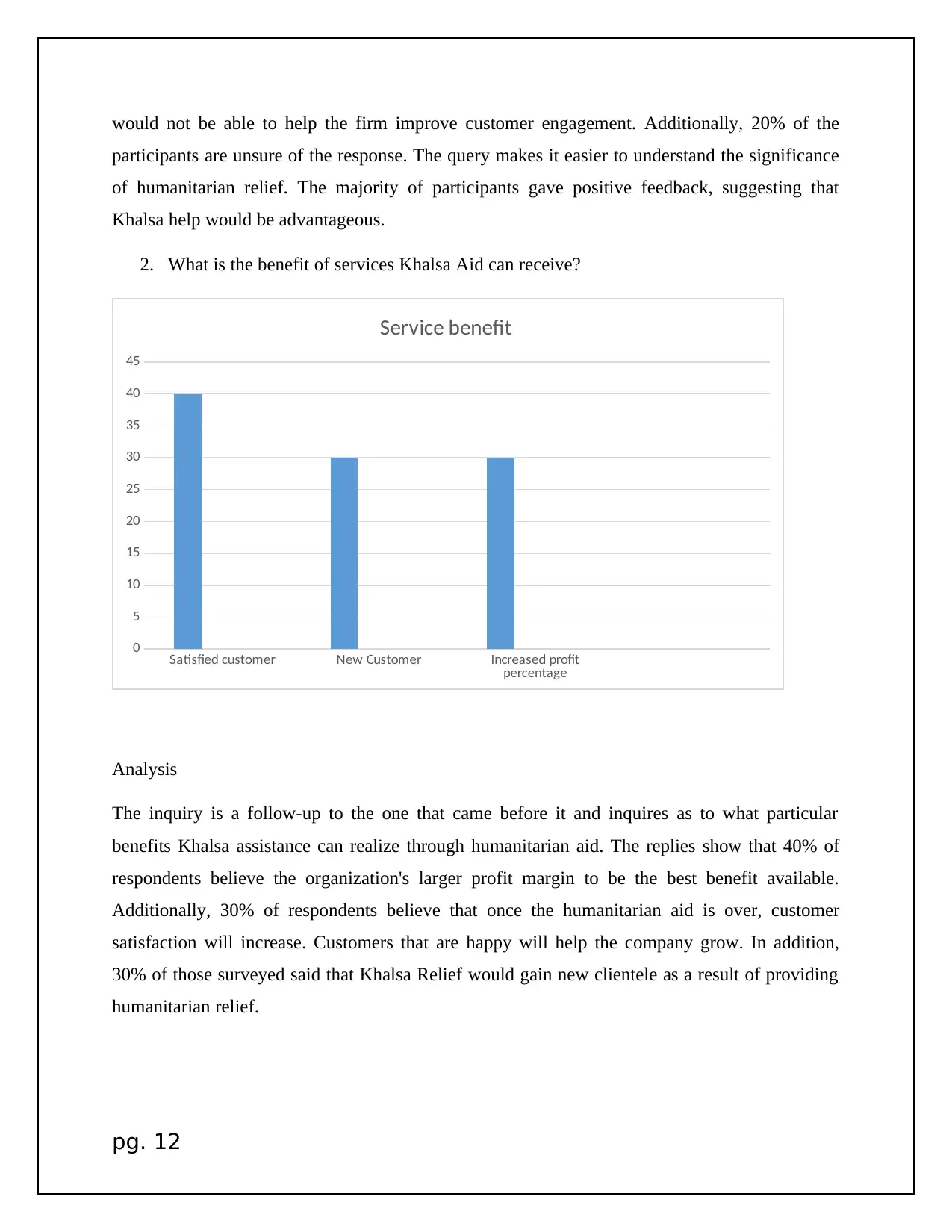
would not be able to help the firm improve customer engagement. Additionally, 20% of the
participants are unsure of the response. The query makes it easier to understand the significance
of humanitarian relief. The majority of participants gave positive feedback, suggesting that
Khalsa help would be advantageous.
2. What is the benefit of services Khalsa Aid can receive?
Satisfied customer New Customer Increased profit
percentage
0
5
10
15
20
25
30
35
40
45
Service benefit
Analysis
The inquiry is a follow-up to the one that came before it and inquires as to what particular
benefits Khalsa assistance can realize through humanitarian aid. The replies show that 40% of
respondents believe the organization's larger profit margin to be the best benefit available.
Additionally, 30% of respondents believe that once the humanitarian aid is over, customer
satisfaction will increase. Customers that are happy will help the company grow. In addition,
30% of those surveyed said that Khalsa Relief would gain new clientele as a result of providing
humanitarian relief.
pg. 12
participants are unsure of the response. The query makes it easier to understand the significance
of humanitarian relief. The majority of participants gave positive feedback, suggesting that
Khalsa help would be advantageous.
2. What is the benefit of services Khalsa Aid can receive?
Satisfied customer New Customer Increased profit
percentage
0
5
10
15
20
25
30
35
40
45
Service benefit
Analysis
The inquiry is a follow-up to the one that came before it and inquires as to what particular
benefits Khalsa assistance can realize through humanitarian aid. The replies show that 40% of
respondents believe the organization's larger profit margin to be the best benefit available.
Additionally, 30% of respondents believe that once the humanitarian aid is over, customer
satisfaction will increase. Customers that are happy will help the company grow. In addition,
30% of those surveyed said that Khalsa Relief would gain new clientele as a result of providing
humanitarian relief.
pg. 12
⊘ This is a preview!⊘
Do you want full access?
Subscribe today to unlock all pages.

Trusted by 1+ million students worldwide
1 out of 28
Related Documents
Your All-in-One AI-Powered Toolkit for Academic Success.
+13062052269
info@desklib.com
Available 24*7 on WhatsApp / Email
![[object Object]](/_next/static/media/star-bottom.7253800d.svg)
Unlock your academic potential
Copyright © 2020–2025 A2Z Services. All Rights Reserved. Developed and managed by ZUCOL.





